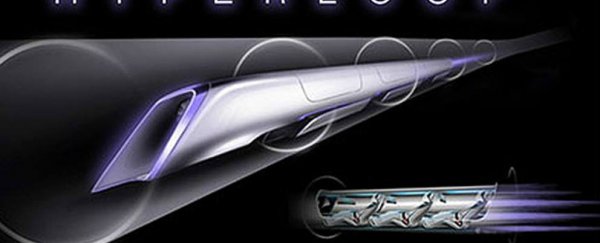Plans to build Elon Musk's proposed Hyperloop train, which could theoretically travel faster than an airplane, are getting excitingly real, with a company signing a deal to build the world's first Hyperloop test track in central California.
The 8-km (5-mile) pilot project won't be long enough to reach the proposed 1,200 km/h (800 mph) speeds of the Hyperloop train, but it's a crucial first step, and is expected to begin construction at the start of next year.
The Hyperloop was first proposed by Musk, the CEO of Tesla Motors and SpaceX, in 2013, and works by transporting passengers through low-pressure tubes inside little pods at incredibly high speeds - sort of like the way mail used to be sucked around building using pneumatic tubes. This system, in theory, is incredibly cheap and energy-efficient to run, and could comfortably take passengers from Los Angeles to San Francisco in a mind-blowing 30 minutes.
But despite coming up with a 57-page white paper outlining the idea, Musk admitted that he didn't have time to work on the project, and at the end of last year, a group of engineers called Hyperloop Transportation Technologies Inc began crowd-funding their own Hyperloop research. And they're wasting not any time, with Ryan Citron over at Navigant Research Blog reporting that they've struck a deal with landowners to build an estimated US$100 million pilot track along California's Interstate 5 highway, which connects LA with San Francisco.
The Hyperloop works by creating a partial vacuum inside a giant tube, which allow pods to accelerate without friction to incredible speeds, guided by magnets. The pods will be cushioned against the walls of the tubes using a series of fans on each side, and the whole thing will be powered by solar panels running along the length of the tube, according to Musk's original designs.
Along a roughly 160-km (100-mile) track, this system should be able to reach speeds of 1,200 km/h, but the engineers behind the project told Wired last year that the train could get even faster, potentially reaching up to 6,500 km/h (4,000 mph) - a speed that would take you from New York to China in two hours. You can see a digital demonstration of the system below:

While the science behind the system seems pretty solid, questions remain over whether it'll actually work in practice, and if it'll be safe for people to be whizzed around the country at such incredible speeds.
"The whole system is vulnerable to a single-point failure," retired physicist and co-inventor of the superconducting maglev concept, James Powell, told Tanya Lewis over at LiveScience. "The guideway [track] has to be built to very fine tolerances, because if the position of the wall deviates from straightness by a few thousandths of an inch, you could crash."
This new test track will hopefully help the team nut out some of these issues. With the potential to reach 322 km/h (200 mph), the pilot system will be considerably slower than the world's fastest maglev trains, but it's still enough to prove whether the system will work or not. Musk has also announced that he'll be building a Hyperloop test track, most likely in Texas, for companies and students to experiment with.
After the initial proof of concept, the challenge will be scaling-up the project. Given the current construction costs, it would require around US$8 billion to build a track from LA to San Francisco. That sounds like a lot, but it's still cheaper than the proposed US$67.7 billion California High-Speed Rail project.
Although we've still got a long way to go before we're hopping in our own little pods and zipping off to China in the time it takes to watch two episodes of Game of Thrones, we can't help but get excited. After all, in two short years the Hyperloop has gone from a crazy idea to a test track agreement. Who knows where we'll be in another 24 months? Watch this space.
